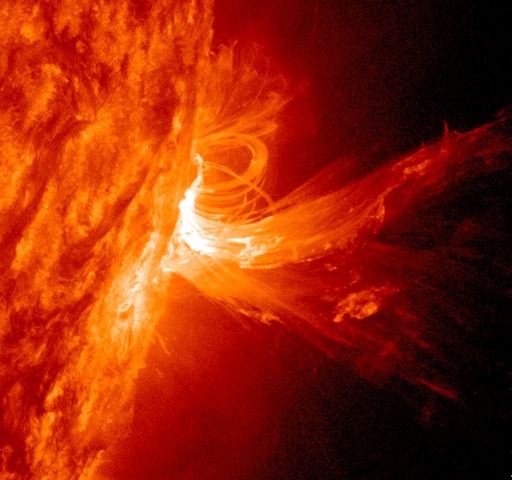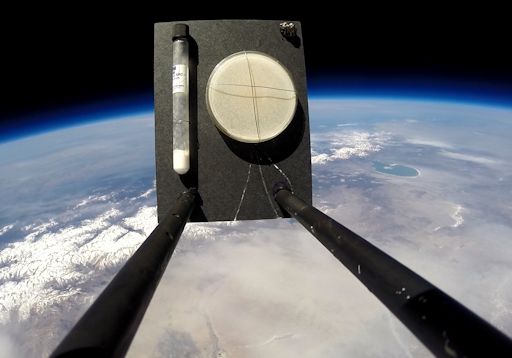When is the best time to see auroras? Where is the best place to go? And how do you photograph them? These questions and more are answered in a new book, Northern Lights - a Guide, by Pal Brekke & Fredrik Broms. | | | METEOR SHOWER UPDATE: The eta Aquarid meteor shower, caused by debris from Halley's Comet, is still active on May 7th. Incoming data from the Canadian Meteor Orbit Radar show a hot spot of meteor activity near the head of Aquarius. These meteors are best seen during the dark hours before sunrise. Set your alarm for dawn and take a look! [photo gallery] [meteor radar] PARTING SHOT: The odds of a geoeffective solar flare are dropping as sunspot AR2051 rotates off the visible solar disk. NASA's Solar Dynamics Observatory recorded this parting shot during the late hours of May 6th: 
This plume of plasma, propelled away from the sun's surface by an M-class explosion in the sunspot's magnetic canopy, is as tall as a dozen planet Earths. Much of the material escaped the sun in the form of a coronal mass ejection (CME), not Earth-directed: movie. Stronger blasts are possible on May 7th. The sunspot has a 'delta-class' magnetic field that harbors energy for powerful X-flares. Any such eruptions, however, will almost surely miss our planet as AR2051 heads for the farside of the sun. Solar flare alerts: text, voice Realtime Space Weather Photo Gallery A ROUGH RIDE FOR HALOBACTERIA: Extremophiles have returned to the Edge of Space. On May 4th, for the second time in less than a month, the students of Earth to Sky Calculus launched a suborbital helium balloon carrying a colony of halobacteria. Here they are at the apex of the flight, almost 32 km high: 
A similar colony made the same flight on April 20th. Despite being zapped by radiation 25x more intense than Earth-normal and freezing solid in temperatures as low as -60C, those bacteria are now thriving in the student's AP Biology Lab in Bishop, California. They seemed to enjoy their ride to the top of Earth's atmosphere. Will these bacteria fare as well? When the bacteria landed in a remote area of Nevada, they hit the desert floor hard; the agar "went splat" at the moment of impact. Today, the students are culturing the battered bacteria to find out how hardy they really are. Stay tuned for updates from the incubator. MOTHER'S DAY AT THE EDGE OF SPACE: Mother's Day is right around the corner. Looking for a unique gift? How about an Edge of Space Mother's Day Card? The students of Earth to Sky Calculus are about launch another helium balloon to the stratosphere. For only $49.95, your Mother's Day, Father's Day, birthday or anniversary card could be on the payload. Profits from the flight are used to support the students' space weather balloon research program. Contact Dr. Tony Phillips for details.
Realtime Aurora Photo Gallery
Realtime Mars Photo Gallery
Realtime Comet Photo Gallery Every night, a network of NASA all-sky cameras scans the skies above the United States for meteoritic fireballs. Automated software maintained by NASA's Meteoroid Environment Office calculates their orbits, velocity, penetration depth in Earth's atmosphere and many other characteristics. Daily results are presented here on Spaceweather.com. On May. 7, 2014, the network reported 20 fireballs.
(12 sporadics, 8 eta Aquariids) 
In this diagram of the inner solar system, all of the fireball orbits intersect at a single point--Earth. The orbits are color-coded by velocity, from slow (red) to fast (blue). [Larger image] [movies]
Potentially Hazardous Asteroids ( PHAs) are space rocks larger than approximately 100m that can come closer to Earth than 0.05 AU. None of the known PHAs is on a collision course with our planet, although astronomers are finding new ones all the time. On May 7, 2014 there were 1470 potentially hazardous asteroids. Notes: LD means "Lunar Distance." 1 LD = 384,401 km, the distance between Earth and the Moon. 1 LD also equals 0.00256 AU. MAG is the visual magnitude of the asteroid on the date of closest approach. | | The official U.S. government space weather bureau | | | The first place to look for information about sundogs, pillars, rainbows and related phenomena. | | | Researchers call it a "Hubble for the sun." SDO is the most advanced solar observatory ever. | | | 3D views of the sun from NASA's Solar and Terrestrial Relations Observatory | | | Realtime and archival images of the Sun from SOHO. | | | from the NOAA Space Environment Center | | | the underlying science of space weather | | 
